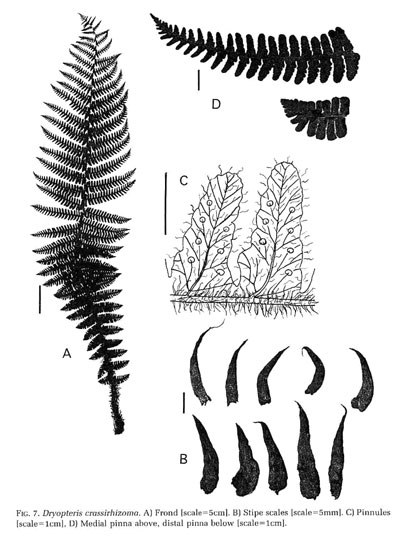| Dryopteris crassirhizoma | ||
|
Etymology
From the Latin Crassus, thick + the Greek rhizoma, mass of roots. But remember that a rhizome is an underground stem.
Description
Rhizome: stout, 10 cm across, erect, bearing more than ten ascending fronds in a beautiful whorl, scales lanceolate to linear, larger ones more than 4 cm long.
Frond: 100 cm high by 20 cm wide, deciduous, monomorphic, blade/stipe ratio: 4:1. Stipe: grooved, straw colored, densly scaly, lanceolate to linear, brown, lustrous, vascular bundles: 3-7 in a c-shaped pattern. Blade: almost 2-pinnate, deltate-ovate to lanceolate, widest at the middle, herbaceous , linear to ovate scales below, absent above. Pinnae: catadromous; costae grooved above, continuous from rachis to costae; segments oblong, rounded; margins crenate; veins free, forked, immersed on upper surface. Sori: round, confined to upper pinnae, indusium: reniform, at a sinus, sporangia: brownish. Culture
Habitat: wooded slopes.
Distribution: Japan, Korea, Manchuria, ne Asia.
Hardy to -25�C, USDA Zone 5.
Synonyms
Dryopteris filix-mas (L.) Schott, misapplied Dryopteris buschiana Fomin Dryopteris setosa Kudo |
|
|
Notes
Persistence Another report: evergreen (Mickel, Ferns for American Gardens)
Persistence Another report: evergreen (Mickel, Ferns for American Gardens)

Dryopteris crassirhizoma. Fertile pinna: more detail on the click-through. �Photo: Tom Stuart |

Dryopteris crassirhizoma. �Illustration from The Cultivated Species of the Fern Genus Dryopteris in the United States, Barbara Joe Hoshizaki and Kenneth A. Wilson, American Fern Journal, 89, 1, (1999), with permission. |
